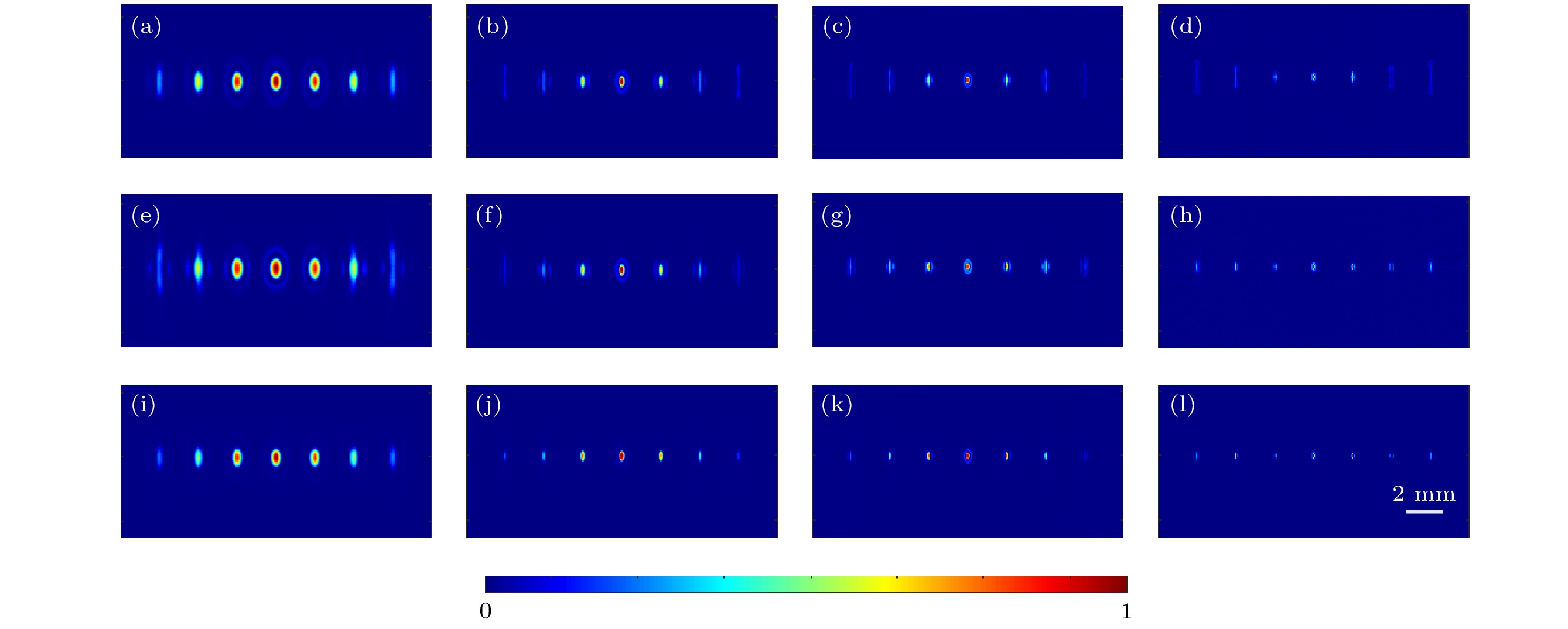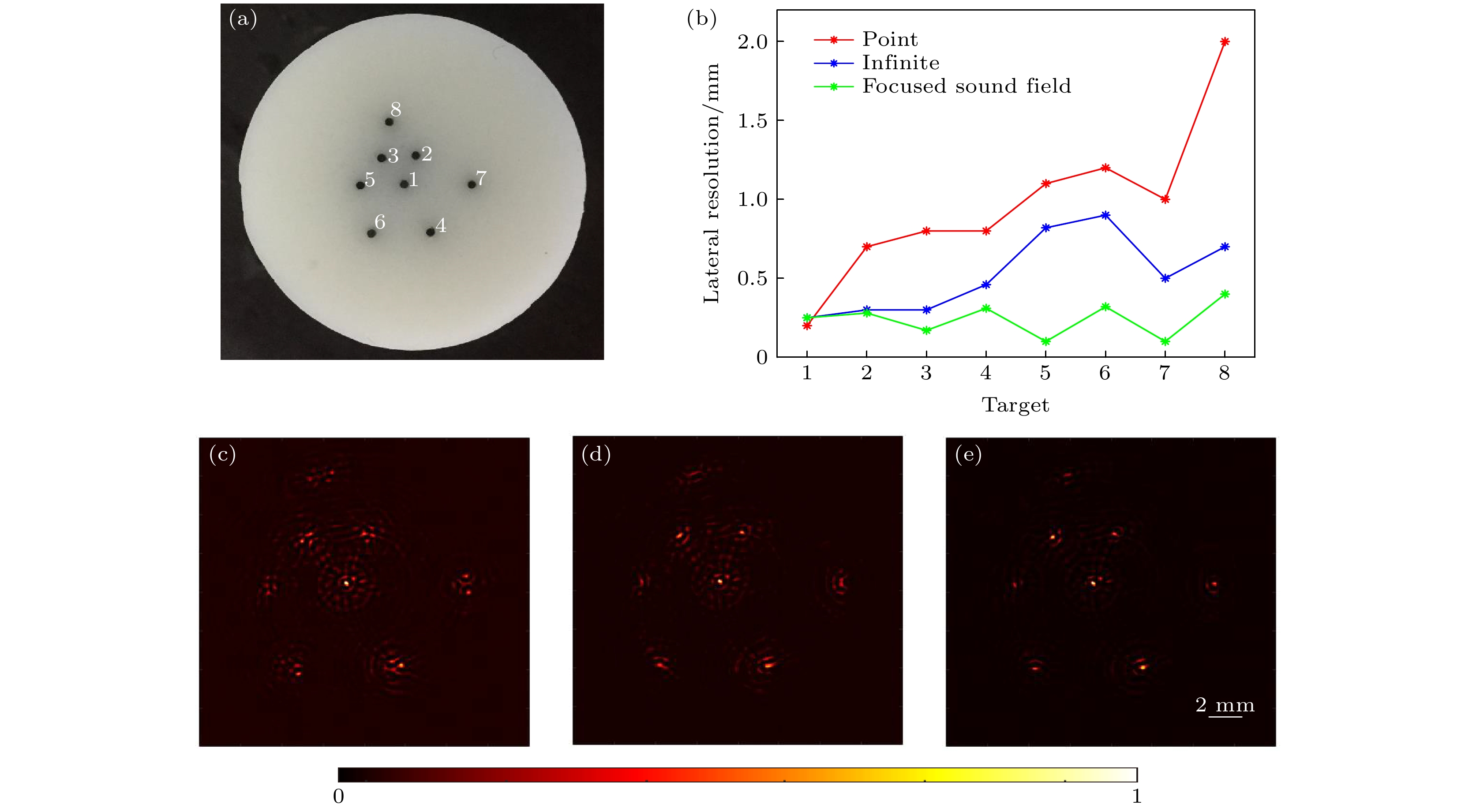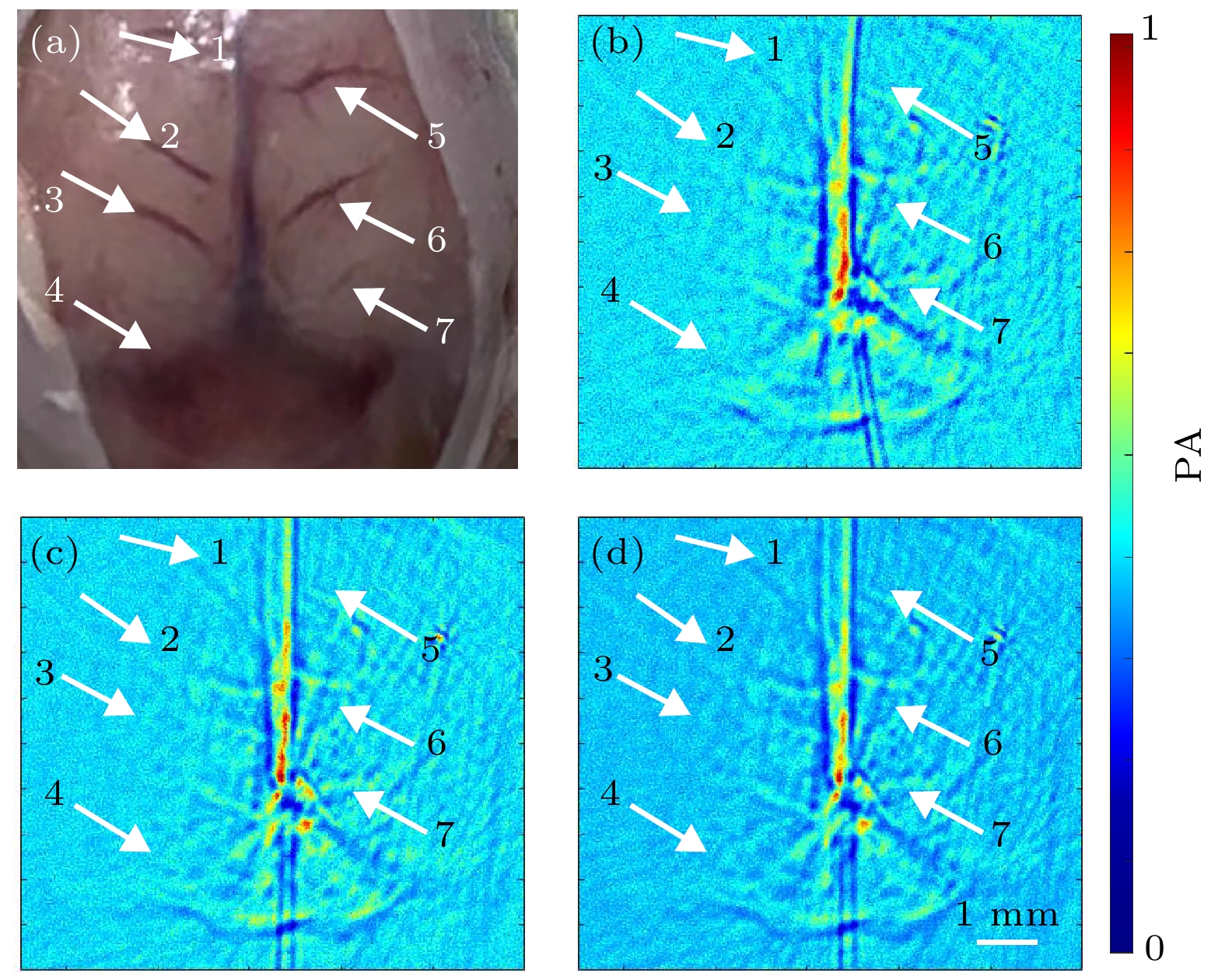-
Photoacoustic tomography is a rapidly developing imaging technology, which can provide structural and functional information of biological tissues. It can integrate the advantage of high optical contrast from optical imaging with those from high penetration depth from ultrasound imaging. However, the existing back-projection algorithm in photoacoustic tomography equates the ultrasonic transducer scanning around the target to a point detector, which leads to a notable tangential blur in the eccentric imaging regions, and thus seriously degrading the image quality. In this paper, we propose a novel photoacoustic tomography reconstruction algorithm, which employs a focused sound field equivalent model to overcome the sound field distortion caused by the transducer’ finite aperture effect and can quickly and effectively restore the elongated tangential resolution in the eccentric imaging regions. Simulation results show that for the target with a diameter of 5 mm and a distance of 6 mm from the rotation center, the tangential resolution is improved by at least twice. Experimental results show that this method can effectively restore the image tangential blur in the off-center regions, where the tiny structures of complex targets can be detected. This new method provides a valuable alternative to the conventional back-projection method and plays an important guiding role in the design of photoacoustic tomography systems based on circle/sphere scanning.
-
Keywords:
- photoacoustic tomography /
- back-projection /
- tangential resolution
[1] Wang L V, Hu S 2012 Science 335 1458
 Google Scholar
Google Scholar
[2] Wang L V, Yao J J 2016 Nat. Methods 13 627
 Google Scholar
Google Scholar
[3] Zhou Y Y, Liang S Y, Li M S, Liu C B, Lai P X, Wang L D 2020 J. Biophotonics 13 e201960229
[4] Zhou Y Y, Cao F, Li H H, Huang X Z, Wei D S, Wang L D, Lai P X 2020 Biomed. Opt. Express 11 2394
 Google Scholar
Google Scholar
[5] Liu Y Y, Fan X, Li Y Y, Qu L L, Qin H Y, Cao Y N, Li H T 2015 Prog. Chem. 27 1459
[6] Yang X M, Maurudis A, Gamelin J, Aguirre A, Zhu Q, Wang L V 2009 J. Biomed. Opt. 14 71770K
[7] Xia J, Wang L H V 2014 Ieee T. Bio-Med. Eng. 61 1380
 Google Scholar
Google Scholar
[8] Menke J 2015 Eur. Radiol. 25 2205
 Google Scholar
Google Scholar
[9] Xiao J Y, Yao L, Sun Y, Sobel E S, He J S, Jiang H B 2010 Opt. Express 18 14359
 Google Scholar
Google Scholar
[10] Wang B, Xiao J Y, Jiang H B 2014 J Neural. Eng. 11 046013
 Google Scholar
Google Scholar
[11] Li M C, Liu C B, Gong X J, Zheng R Q, Bai Y Y, Xing M Y, Du X M, Liu X Y, Zeng J, Lin R Q, Zhou H C, Wang S J, Lu G M, Zhu W, Fang C H, Song L 2018 Biomed. Opt. Express 9 1408
 Google Scholar
Google Scholar
[12] Zhou Y, Yao J J, Wang L H V 2016 J. Biomed. Opt. 21 061007
 Google Scholar
Google Scholar
[13] Burgholzer P, Bauer-Marschallinger J, Grun H, Haltmeier M, Paltauf G 2007 Inverse Probl. 23 S65
 Google Scholar
Google Scholar
[14] Xu M H, Wang L H V 2005 Phys. Rev. E 71 016706
 Google Scholar
Google Scholar
[15] Roitner H, Haltmeier M, Nuster R, O'Leary D P, Berer T, Paltauf G, Grun H, Burgholzer P 2014 J. Biomed. Opt. 19 056011
 Google Scholar
Google Scholar
[16] Li M L, Tseng Y C, Cheng C C 2010 Opt. Express 18 26285
 Google Scholar
Google Scholar
[17] Xu M H, Wang L V 2003 Phys. Rev. E 67 056605
 Google Scholar
Google Scholar
[18] Li C H, Wang L V 2008 Appl. Phys. Lett. 93 033902
 Google Scholar
Google Scholar
[19] Drozdov G, Rosenthal A 2017 Ieee T. Med. Imaging. 36 301
 Google Scholar
Google Scholar
[20] Zhang C, Wang Y Y 2008 J. Opt. Soc. Am. A. 25 2436
 Google Scholar
Google Scholar
[21] Cai D, Li Z F, Li Y, Guo Z D, Chen S L 2017 Opt. Express 25 1421
 Google Scholar
Google Scholar
[22] Luo X F, Xiao J Y, Wang C C, Wang B 2021 Photonics 8 356
 Google Scholar
Google Scholar
-
图 2 不同重建模型的反投影算法示意图 (a)点状换能器模型; (b)无限大小换能器模型; (c)聚焦声场换能器模型
Figure 2. Schematics of the back-projection algorithm of different reconstruction models: (a) The model for point-like ultrasonic transducer; (b) the model for ultrasonic transducer with infinite element size; (c) the model for ultrasonic transducer with focused sound field.
图 3 不同重建模型下换能器中心频率变化的仿真结果 (a)—(d)当中心频率分别为1 MHz, 3 MHz, 5 MHz和10 MHz时, 用传统点模型方法得到的结果; (e)—(h)无限大平面模型的相应结果; (i)—(l)聚焦声场模型的相应结果. 所采用的平面换能器直径为6 mm, 7个点的位置分别为–6 mm, –4 mm, –2 mm, 0 mm, 2 mm, 4 mm和6 mm. 在模拟数据中加入5%的噪声, 所有图像的振幅都归一化为1
Figure 3. Simulation results with different reconstruction methods when the transducer central frequency varies: (a)–(d) The results with the conventional point-like method when the central frequency are 1 MHz, 3 MHz, 5 MHz and 10 MHz, respectively; (e)–(h) the corresponding results with the model of the infinite element size; (i)–(l) the corresponding results with the model of focused sound field. The diameter of the employed planar transducer was 6 mm, and the locations of the seven points are –6 mm, –4 mm, –2 mm, 0 mm, 2 mm, 4 mm, and 6 mm, respectively. The simulated data were added with 5% noise, and the amplitudes of all the images were normalized to 1 for comparison.
图 4 由3 MHz中心频率超声换能器模拟得到的4个目标的横向剖面, 红线、蓝线和绿线分别表示点状换能器模型、无限大小换能器模型和聚焦声场换能器模型的结果 (a) 0 mm; (b) 2 mm; (c) 4 mm; (d) 6 mm
Figure 4. The simulated lateral profiles for the four targets obtained from 3 MHz central frequency ultrasonic transducer. The locations of the four points are 0 mm (a), 2 mm (b), 4 mm (c), and 6 mm (d), respectively. The red, blue and green lines represent the results from the conventional point-like model, the infinite element size model, and the focused sound field model, respectively.
图 6 不同重建算法对点目标成像的实验结果 (a)仿体照片; (b)8个点目标的切向分辨率分布图; (c)点状模型BP算法; (d)无限大小模型BP算法; (e)聚焦声场模型BP算法
Figure 6. The experimental results of point target imaging with different reconstruction algorithms: (a) The photograph of phantom; (b) tangential resolution distributions of eight point targets; (c) the BP method of point-like model; (d) the BP method of infinite element size model; (e) the BP method of focused sound field model.
图 7 不同重建算法对小鼠模型成像的实验结果 (a)小鼠脑图片; (b)点状模型BP算法; (c)无限大小模型BP算法; (d) 聚焦声场模型BP算法
Figure 7. The experimental results of mouse brain imaging with different reconstruction algorithms: (a) The photograph of the mouse brain; (b) the BP method of point-like model; (c) the BP method of infinite element size model; (d) the BP method of focused sound field model.
表 1 Table 1 不同算法和换能器频率下偏离中心6 mm目标的FWHM和SNR
Table 1. The FWHM and SNR results of 6 mm off-center target with different methods and transducer frequencies.
中心频率 点状 无限大小 聚焦声场 1 MHz FWHM/mm 1.85 1.05 0.85 SNR/dB 36.06 26.17 36.80 3 MHz FWHM/mm 1.25 1.04 0.42 SNR/dB 28.78 27.29 33.87 5 MHz FWHM/mm 0.93 0.82 0.38 SNR/dB 26.42 24.07 28.09 10 MHz FWHM/mm 0.45 0.41 0.25 SNR/dB 22.90 16.75 25.31 -
[1] Wang L V, Hu S 2012 Science 335 1458
 Google Scholar
Google Scholar
[2] Wang L V, Yao J J 2016 Nat. Methods 13 627
 Google Scholar
Google Scholar
[3] Zhou Y Y, Liang S Y, Li M S, Liu C B, Lai P X, Wang L D 2020 J. Biophotonics 13 e201960229
[4] Zhou Y Y, Cao F, Li H H, Huang X Z, Wei D S, Wang L D, Lai P X 2020 Biomed. Opt. Express 11 2394
 Google Scholar
Google Scholar
[5] Liu Y Y, Fan X, Li Y Y, Qu L L, Qin H Y, Cao Y N, Li H T 2015 Prog. Chem. 27 1459
[6] Yang X M, Maurudis A, Gamelin J, Aguirre A, Zhu Q, Wang L V 2009 J. Biomed. Opt. 14 71770K
[7] Xia J, Wang L H V 2014 Ieee T. Bio-Med. Eng. 61 1380
 Google Scholar
Google Scholar
[8] Menke J 2015 Eur. Radiol. 25 2205
 Google Scholar
Google Scholar
[9] Xiao J Y, Yao L, Sun Y, Sobel E S, He J S, Jiang H B 2010 Opt. Express 18 14359
 Google Scholar
Google Scholar
[10] Wang B, Xiao J Y, Jiang H B 2014 J Neural. Eng. 11 046013
 Google Scholar
Google Scholar
[11] Li M C, Liu C B, Gong X J, Zheng R Q, Bai Y Y, Xing M Y, Du X M, Liu X Y, Zeng J, Lin R Q, Zhou H C, Wang S J, Lu G M, Zhu W, Fang C H, Song L 2018 Biomed. Opt. Express 9 1408
 Google Scholar
Google Scholar
[12] Zhou Y, Yao J J, Wang L H V 2016 J. Biomed. Opt. 21 061007
 Google Scholar
Google Scholar
[13] Burgholzer P, Bauer-Marschallinger J, Grun H, Haltmeier M, Paltauf G 2007 Inverse Probl. 23 S65
 Google Scholar
Google Scholar
[14] Xu M H, Wang L H V 2005 Phys. Rev. E 71 016706
 Google Scholar
Google Scholar
[15] Roitner H, Haltmeier M, Nuster R, O'Leary D P, Berer T, Paltauf G, Grun H, Burgholzer P 2014 J. Biomed. Opt. 19 056011
 Google Scholar
Google Scholar
[16] Li M L, Tseng Y C, Cheng C C 2010 Opt. Express 18 26285
 Google Scholar
Google Scholar
[17] Xu M H, Wang L V 2003 Phys. Rev. E 67 056605
 Google Scholar
Google Scholar
[18] Li C H, Wang L V 2008 Appl. Phys. Lett. 93 033902
 Google Scholar
Google Scholar
[19] Drozdov G, Rosenthal A 2017 Ieee T. Med. Imaging. 36 301
 Google Scholar
Google Scholar
[20] Zhang C, Wang Y Y 2008 J. Opt. Soc. Am. A. 25 2436
 Google Scholar
Google Scholar
[21] Cai D, Li Z F, Li Y, Guo Z D, Chen S L 2017 Opt. Express 25 1421
 Google Scholar
Google Scholar
[22] Luo X F, Xiao J Y, Wang C C, Wang B 2021 Photonics 8 356
 Google Scholar
Google Scholar
Catalog
Metrics
- Abstract views: 7565
- PDF Downloads: 90
- Cited By: 0















 DownLoad:
DownLoad:






